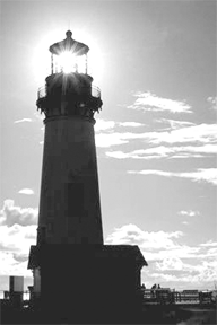|
The Light at the End of the
Delaware |
||
| I am trying to get used to the harness
tangled around my Mustang while keeping the ship on its course. It is
cold, rainy, the wind is fierce. A little while back we followed the
treacherous-looking rocky bulwark of Egg Island, and its Point light is
now slowly fading behind us. Ahead is darkness, except for a light pulsing
two seconds on, two seconds off. During the next few hours I will grow
very fond of this four-second rhythm.
It was in May, and we had just bought our first boat. Although I had my
initial taste of sailing five years earlier on Lake Texoma, I had really
learned to sail only the previous summer, but in the best possible way: on
small centerboard sailboats where, whenever you make a mistake, you taste
the water. |
In the morning, the forecast had called for
25 knot winds on the Delaware, with four to six foot waves. For a Laser
guy like me, it was a bit difficult to judge the meaning of this for a 30
foot ship, but I had worried some about it, since all the sailors I talked
to in Knapps Narrows seemed to be incapable of mentioning the Delaware
without cursing or scowling. From what I had heard, if you see a sailboat
on the Delaware at all, it is just passing through. But I had failed to
get some reference point such as under what conditions one should avoid
crossing the Delaware. The odds were good that the winds would be on the nose, with good-sized waves; but the captain said let's go, so we went. When we entered the bay, we came upon the recovery operation for a tugboat that had sunk there a day or two before. Maybe this should have been a sign. We moved on. At first this was fun, encountering the first real waves with our new ship, testing her steadfastness, and getting a good heel. This was getting to be as sporty as a Laser. But as the day went on, the conditions worsened. Julie soon gave up the title of Cookie for the day, and could not even be bothered to come up to see the dolphins we encountered. I guess her green color had something to do with it. It became evident that the weather would do what the forecasters had announced, and then some. Our reaching Cape May in daytime was compromised since we had to tack so often. Now, as night has come, the wind has picked up some more. The waves are short and choppy, just as the scowling Knapps Narrows sailors implied. Peace Maker is not peaceful at all. It's time to reef again and get the harnesses out. This has had a certain effect on this green crew (I am using the term green as in rookie, not as in Cookie). I have stayed at the helm while our captain goes forward to do the reefing. It is now that I see the Light. My first reaction is one of relief - I see the Cape May lighthouse, therefore we are almost there. I am of course very wrong. Oh, it's the Cape May lighthouse all right, but it will take me all night to remember all the lessons one learns when reading sailors' story. The lesson that distances at night are misleading is certainly important. But the one that will touch me much deeper, that I will understand to my core and not only in my mind, is the love, the almost religious fervor that sailors have for the lighthouse in the night. For hours on end, this will be the only reassuring point in the dark. Other lights come and go. A cargo crosses our path - never really close to us or a threat to our ship, but a potential danger, a drifter, an unknown character. Even stranger is a motor boat bouncing on the waves at full speed with its three-million-candle front spotlight madly bobbing right and left with its bow. I cannot understand how the crew aboard could possibly hang on. This guy must be duct taped to his wheel. Since it doesn't seem to go in a straight line, and with its spot probably blinding him in the rain, it is certainly a worry. A bit like a drunken man running in the street with a knife in his hands is more likely to hurt himself than anyone else, unless you are too close... But the Light is there. Patient, unshakeable. Just like your parents' home when everything around is dark and uncertain. You know that if you make it there, there will be a good meal, someone will listen to you, and you will have a safe place to spend the night. The Light becomes the only certain indication in the night. She calls you toward calmer water, guiding you to her baby lights, her green and red lights spread at her feet like a tiny yellow brick road. Two seconds on, two seconds off, two seconds on, two seconds off. I now know why, for centuries, sailors have had an almost mystical relationship with those man-made gleams of hope on the horizon. Two seconds on, two seconds off...  |
|
